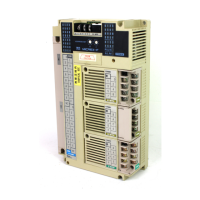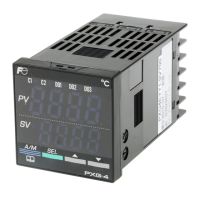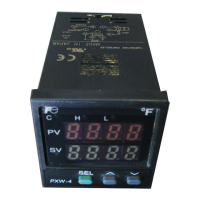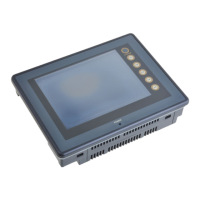– 16 –
Setting code (AT)
012
When auto-tuning
is cancelled or not
performed.
Standard type
(auto-tuning at SV)
Low PV type (auto-
tuning at 10%FS
below SV.)
Start of AT
End of AT
PV
PID control
Start of AT
End of AT
PV
PID control
SV-10%FS
Set value (SV)
Set value (SV)
q Standard type (AT=1)
(a) The P.I.D. parameter calculated by auto-tuning remains even if the power is turned off. If the power is
turned off before the auto-tuning is completed, you must restart the auto-tuning.
(b) The PV may be changed greatly depending on the process, because the con trol output is ON/OFF action
(two position operation) in the auto-tuning. So, do not use the auto-turning if the process does not allow a
significant variation of PV.
In addition, the auto-tuning should not be used in any process such as pressure control and flow control,
where a quick-response is required.
(c) If the auto-tuning isn’t completed in four hours, the auto-tuning is suspected to fail. In this case, check the
wiring and parameters such as the control action,
input type, etc.
(d) Carry out the auto-tuning again, if there is any change in SV, input range (P-SL, P-SV or P-dP) or process
condition. Perform the auto-tuning if fuzzy control is selected as the control algorithm.
(e) When resetting the AT parameter, set the parameter to “0” once, then reset it.
6-2 Auto-tuning (AT)
Autotuning is the automatic calculation and entering of the control parameters (P,I and D) into memory. Prior
to the auto-tuning, complete the setting of input range
(P-SL,P-SU, P-dP), a set value (SV), alarm setting (AL1, AL2), and cycle time (TC).
Set the parameter AT as either “1” or “2” by using or key, and press the
SEL
key to start the auto-turning.
Then the point indicator at the lower right starts blinking. At the completion of Auto-tuning, the point indicator
stops blinking, then parameter AT is automatically set to 0.
How to start the auto-tuning
w Low PV type (AT=2) :
Overshoot decreased
at tuning.

